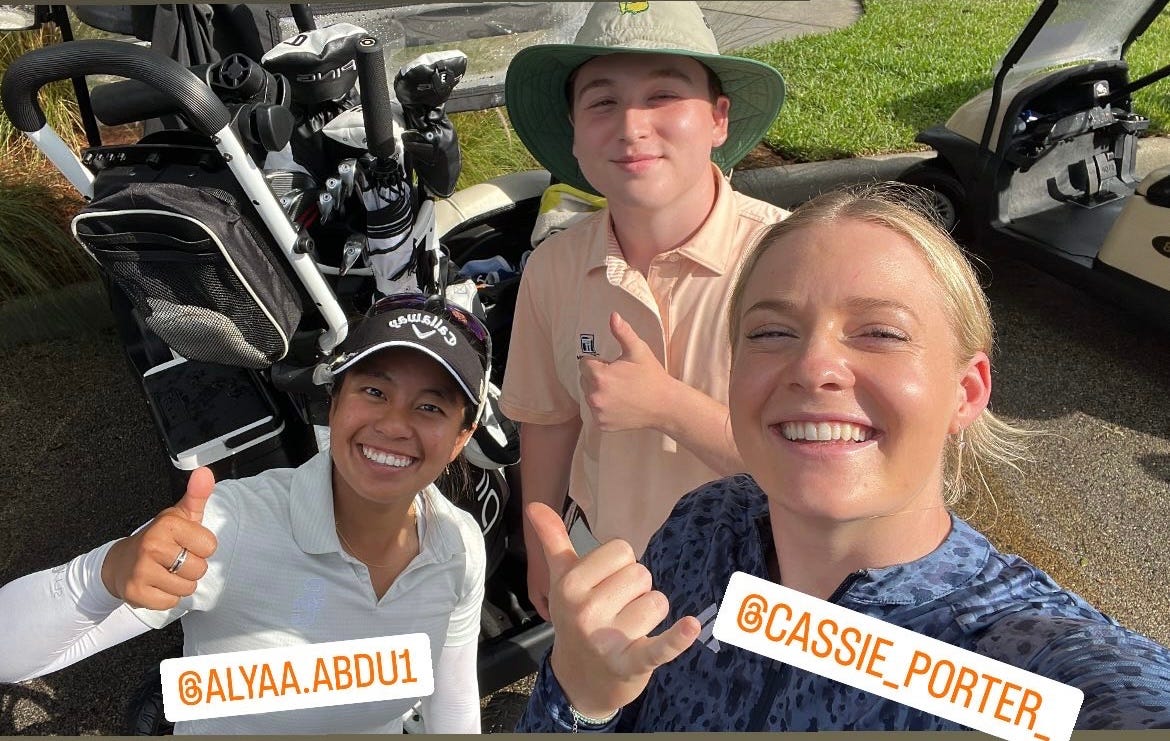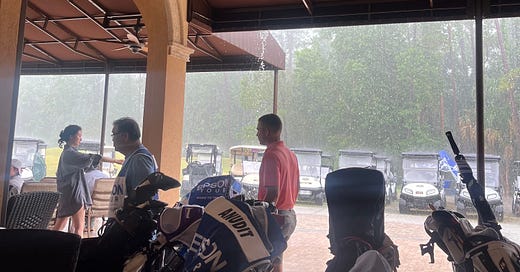The Reality in a Rain Delay
I got to see professional golf in its rawest form thanks to Orlando-area weather.

Dark clouds loom. The horn blows. Everyone collectively groans. It’s the beginning of an indeterminately long rain delay.
They’re every golfer’s nightmare.
Last week, my first on the bag for Alyaa Abdulghany, we had to sit through two of them totaling five hours. I learned a lot during those long periods, and they helped clarify what I saw on the course when the competition began.
These rain delays kill mojo, but they give a unique insight into professional golf’s dynamics
Waiting the delays out on the back patio of the Alaqua Country Club’s clubhouse was reminiscent of the numerous times that I was rain-delayed in middle and high school golf. Although, this week, I was surrounded by much, much, much better players (it was just a little intimidating).
In-between cautious checks of the weather and, when we were delayed early in the second round, checks of the leaderboard, the players were united through a genuine commitment to killing the time and stress by keeping things light.
Alyaa and her friends on tour, many who she knows from her time at USC, were clearly disappointed about having to be off the course but seemed happy to spend time together in a laid-back setting.
We had a rousing game of “Heads Up” going, with Ellie Slama providing keen impressions of a multitude of accents for the game. Water bottle flipping was also a source of fascination during the rain delay, as Alyaa and Tristyn Nowlin attempted to find the perfect water to air ratio in the bottle to successfully land each flip.
I even got a chance to explain the importance of eating at the most run-down Eastern NC barbecue joint to Cassie Porter, an Australian player, when she drives from Raleigh to New Bern for next week’s tournament.
There was a certain tension, though. Not necessarily between the players, but between the players and the unique randomness of tournament golf. During our practice round delay, each player consistently said how much they wanted to call it for the day, but how they had to hold out hope for a chance to see the course.
When we were delayed four holes into our second round, everyone especially wanted to resume to get at least nine holes in to prevent a 12-hour long Sunday.
Also looming over every player’s heads? The cut line. The difference between making money and not, it’s always present, no matter how far away from it you are.
While everyone was laughing and smiling with genuine friends, there were always other things on the mind.

Similar dynamics played out on course, much to my surprise
During our competitive rounds, I was genuinely jolted at how much Alyaa, Gabi Ruffels, and Karen Chung chatted. I knew they were friends, considering they all went to USC (Alyaa and Gabi were even travel roommates), but I had figured that the intensity of competition would make the walks down the fairways silent.
Instead, the players talked frequently, even sharing umbrellas for shade towards the end of the second round.
Most of the conversation was distinctly non-golf. I remember having a conversation with Alyaa and Gabi about the merits of boba tea (sorry, Alyaa, I just can’t get behind the beverage).
Even between Alyaa and I, the conversation was pretty light for the majority of our two competitive rounds. For one, I learned that I’ve got to check out The Echo Wife, as it’s the book she wants to experience for the first time again.
We also talked about our favorite board games, our New Year’s Resolutions, and our steadfast refusal to wear watches.
While fun, the thing about professional athletes is that they know exactly when to turn it on
As soon as players started preparing for their shots, there was a distinct silence that pierced the heavy Florida air. Yardages were determined, lines were considered, and the players locked in.
When it was time to get serious, we got serious.
They may be friends but at the end of the day their livelihoods depend on the quality of the shots they hit. They’re all competing against one another for the biggest slice of the collective pie.
That doesn’t mean that anyone is actively rooting against anyone, as evidenced by the consistent remarks of “good shot” in our group.
It just means that the competition is first and foremost. It’s never out of anyone’s mind and speaks to how real professional tournament golf is. The stakes are the ability to put food on the table and travel to the next tournament, not the bragging rights that seemed so important in high school.
This is an entirely foreign world to most golfers
Even after missing the cut by a stroke, and thus making $0 for the week, Alyaa was smiling and talking with the other players and taking bananas and peanut butter from the player dining area for me.
It served as a stark reminder of the duality of golf at this level. It’s both a game and a career. You try to keep things light, but the game will still burn you.
We rarely get to see this struggle for survival on television, where players are competing for millions of dollars and have a vast array of sponsorships. At last week’s PGA Championship, the lowest-paid player won $25,000. For the IOA Golf Classic, the lowest-paid players made $701, barely enough to cover the entry fee of $450, not to mention travel, food, and lodging for the tournament.
This week, Alyaa and 143 other players will be back at it for the Inova Mission Inn Resort & Club Championship. Over half of the field will leave with nothing. Some people will leave with just enough to keep going for another month or two.
That’s what sports do to you, though. Despite the struggle, despite the setbacks, and despite the instability, they keep bringing you back.
The stakes are astronomical for these players, but at the end of the day, they all love the game and the pure, competitive nature of their careers.
This dynamic is never easy, so it helps to keep things fun when you can.
Who doesn’t love discussing their favorite video games while waiting on a tee box?
Questions, comments, ideas, and feedback can be directed to jpatterson@unc.edu. You can find me on Twitter @JakeWPatt or my Instagram @Loopers_Line. If you really want to get to know me, check out my LinkedIn.
Special thanks to Bethany Phillis for serving as my creative project mentor. Additional thanks to Caroline Maness for designing Looper’s Line’s logo.



